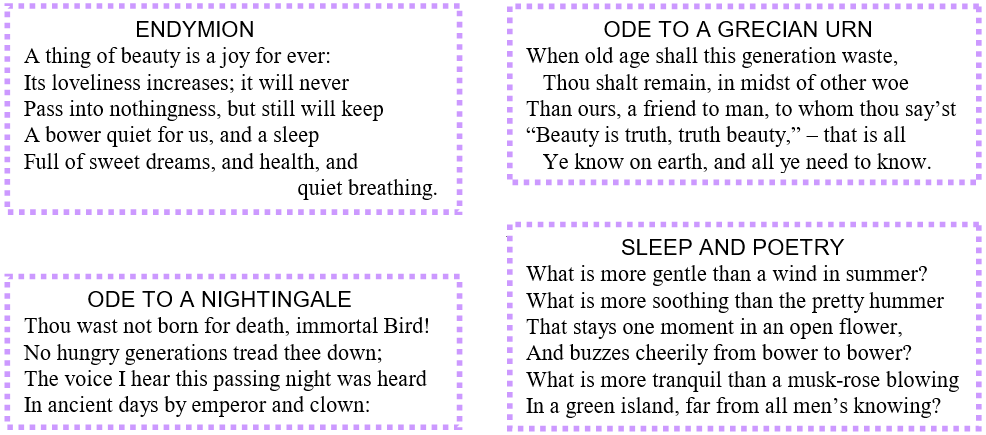


xxxxxThe English romantic poet John Keats studied medicine, but turned to writing poetry in 1817, encouraged by the poet Leigh Hunt. His first major work, a long allegorical poem entitled Endymion, was severely criticised as being too ornate, but during a period of extreme personal distress, 1818 to 1820, he produced some of the finest poetry in English literature. This included his romantic narrative The Eve of St. Agnes, his ancient ballad La Belle Dame sans merci, his medieval narrative Isabella, and, above all, his famous set of Odes, notably To a Nightingale (1819), On a Grecian Urn and To Autumn. In these beautifully composed verses he compared the permanence of beauty with the inevitable sadness and uncertainty of human life. Meanwhile his own life had its share of sadness. In 1818 his brother Tom died of tuberculosis, and Keats discovered that he had also contracted the disease. This, together with his lack of money, put an end to his hopes of marrying his beloved Fanny Brawne. In 1821 he settled in Rome, hoping this might prolong his life, but he died there in February the following year, aged 26. He numbered among his friends the poets Percy Bysshe Shelley, Samuel Taylor Coleridge and William Wordsworth.
JOHN KEATS 1795 -
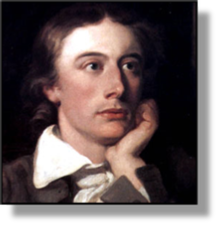 xxxxxJohn Keats, alongside his contemporaries Percy Bysshe
Shelley and Lord Byron, was one of England’s outstanding romantic
poets. He died at the age of 26, but in his short life he produced
some of the finest poetry in English literature. A Londoner by
birth, he was the son of an ostler, a stableman at a local inn in
Moorfields. He led an active life as a youngster, but his father was
killed in a riding accident when he was nine, and his mother died of
the family illness, consumption, when he was in his teens. He
attended a school at Enfield -
xxxxxJohn Keats, alongside his contemporaries Percy Bysshe
Shelley and Lord Byron, was one of England’s outstanding romantic
poets. He died at the age of 26, but in his short life he produced
some of the finest poetry in English literature. A Londoner by
birth, he was the son of an ostler, a stableman at a local inn in
Moorfields. He led an active life as a youngster, but his father was
killed in a riding accident when he was nine, and his mother died of
the family illness, consumption, when he was in his teens. He
attended a school at Enfield -
xxxxxHe had produced a number of poetic works earlier, but it was not until the publication in Hunt’s periodical The Examiner of his two poems, O Solitude if I with Thee Must Dwell and On First Looking into Chapman’s Homer, that his work attracted attention. There followed his Poems, published in 1817 and containing a number of notable sonnets, including Sleep and Poetry, a poem stressing the need for a poet to experience the “agony and strife of human hearts”. His first major work, however, Endymion, an ambitious allegorical poem over 4,000 lines in length, did not appear until the following year, and it was far from a success. The style employed, owing much to that of Hunt, was seen as contrived and over elaborate. The reviews in both Blackwood’s Magazine and the Quarterly Review pulled no punches. Critics described the work as nonsense, poured scorn on Hunt’s “cockney school of poetry”, and went so far as to suggest that Keats should go back to studying medicine. Keats openly admitted that the poem was the product of his “inexperience and immaturity” though, in fact, it did contain passages of remarkable splendour, and its search for ideal beauty, woven on this occasion round the classical legend of the love of the moon goddess for a mere mortal shepherd, was a theme to which he was frequently to return.
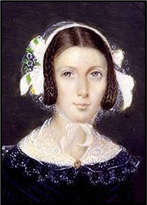 xxxxxBut this failure was but a minor contribution to the
personal crisis endured by the young Keats at this time. In the same
year, 1818, his brother Tom died of tuberculoses, and he himself
contracted the disease. And this, together with his constant lack of
money, virtually put an end to any hopes he might still have had of
marrying Fanny Brawne (illustrated), a young woman with whom he was passionately in love.
Yet despite such anguish -
xxxxxBut this failure was but a minor contribution to the
personal crisis endured by the young Keats at this time. In the same
year, 1818, his brother Tom died of tuberculoses, and he himself
contracted the disease. And this, together with his constant lack of
money, virtually put an end to any hopes he might still have had of
marrying Fanny Brawne (illustrated), a young woman with whom he was passionately in love.
Yet despite such anguish -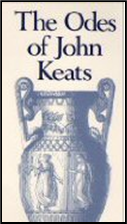 prove
years of great creativity. It began with his romantic narrative The Eve of St. Agnes, a work which has been
compared with the best of Shakespeare, and was followed by the
ancient ballad La Belle Dame sans merci.
Then came Lamia, a vampire that seduced
young men, his medieval narrative Isabella
(an adaptation of a tale by Boccaccio), and the brilliant set of Odes by which he is best remembered today,
including On a Grecian Urn, To
a Nightingale (1819), On
Melancholy, and To Autumn -
prove
years of great creativity. It began with his romantic narrative The Eve of St. Agnes, a work which has been
compared with the best of Shakespeare, and was followed by the
ancient ballad La Belle Dame sans merci.
Then came Lamia, a vampire that seduced
young men, his medieval narrative Isabella
(an adaptation of a tale by Boccaccio), and the brilliant set of Odes by which he is best remembered today,
including On a Grecian Urn, To
a Nightingale (1819), On
Melancholy, and To Autumn -
xxxxxIronically, in one of his last works, The Fall of Hyperion, an epic which he had begun earlier but had left unfinished, Keats looks back on his short poetic career and rededicates himself to the creative art of poetry. In September 1820, however, knowing that he was dying, he sailed to Italy in the hope that a warmer climate would at the least delay his end for a few years. But it was not to be. His illness was too advanced. He died in Rome five months later and was buried in the Protestant cemetery there. The distraught letters he wrote home during his brief stay in Italy, lamenting the love he had lost and the poetic heights he had hoped to achieve, are some of the most moving ever written.
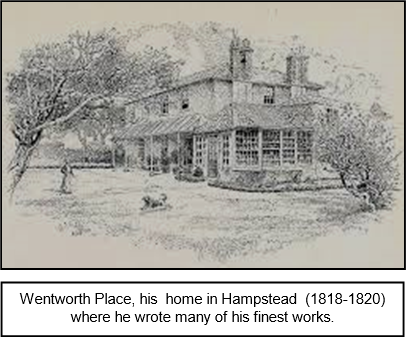 xxxxxKeat’s poetry, dealing though it does with the
bewildering, complex relationships between life and death, love and
suffering, joy and sadness, beauty and decay, is amongst the most
splendid ever written, and in many instances can only be described
as verbal music. His odes, in particular, have a rich, sensuous
quality, and their purity of expression, together with their
imaginative association of ideas, create visual pictures which are
vivid and thought provoking. A wild and emotional young man, he
wrote much on death, suffering and decay, but stressed always the
power of beauty to overcome and outlast them all. And his letters,
too, provide a fascinating insight into the nature of his poetry and
the development of its creator, the poet himself. We are told that
faced with the criticism of his work Endymion
at the start of his poetic career he remarked: “I think I shall be
among the English poets after my death”. This he certainly was, and
it was to be a place amongst the greatest of them.
xxxxxKeat’s poetry, dealing though it does with the
bewildering, complex relationships between life and death, love and
suffering, joy and sadness, beauty and decay, is amongst the most
splendid ever written, and in many instances can only be described
as verbal music. His odes, in particular, have a rich, sensuous
quality, and their purity of expression, together with their
imaginative association of ideas, create visual pictures which are
vivid and thought provoking. A wild and emotional young man, he
wrote much on death, suffering and decay, but stressed always the
power of beauty to overcome and outlast them all. And his letters,
too, provide a fascinating insight into the nature of his poetry and
the development of its creator, the poet himself. We are told that
faced with the criticism of his work Endymion
at the start of his poetic career he remarked: “I think I shall be
among the English poets after my death”. This he certainly was, and
it was to be a place amongst the greatest of them.
xxxxxIncidentally,
in 1821 Shelley wrote Adonais, a lament
for Keats based on a Greek pastoral elegy. In it he alleged that his
death had been hastened by the savage treatment his early work -
xxxxx……
Keats’ sonnet On First Looking into Chapman’s
Homer was inspired by his reading the particularly powerful
and beautiful translations of Homer’s Illiad
and Odyssey by George
Chapman, (c1559-
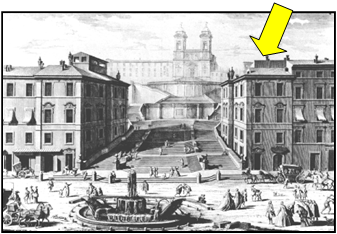
xxxxx…… An outstanding biography of Keats was published by the American poet Amy Lawrence Lowell in 1925. ……
xxxxx…… When in Rome during the last months of his life, Keats lived in a house at the bottom of the Spanish Steps, and it is there that he died (illustrated). The Spanish Steps are sometimes seen as a memorial to both him and his friend Shelley.
XXXXXXXXXXXXXXXXXXXXXXXXXXXXXXXXXXXXXXXXXXXXXXXXXXXXXXXXXX
Extracts from four of his works:
G3c-
Acknowledgements
Keats: detail, by the English
portrait painter William Hilton (1786-
Including:
Leigh Hunt

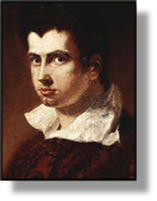 xxxxxThe English poet and essayist Leigh
Hunt (1784-
xxxxxThe English poet and essayist Leigh
Hunt (1784-
xxxxxHe was born in Southgate, Middlesex, and his first poems, written in his early teens, were published by his father in 1801 under the title Juvenilia. For a time he worked as a clerk in the War Office, and during this period he wrote reviews for his brother’s paper The News. In 1808 he and his brother founded The Examiner. As its editor over the next 13 years, he used this periodical to support the romantic movement, and to press for a number of enlightened causes, including Catholic emancipation, the abolition of the slave trade, and parliamentary reform. A staunch liberal, he was prosecuted three times for his outspoken criticism of the government and, on the third occasion, was found guilty. For criticising the Prince Regent and calling him “a fat Adonis of fifty” he was convicted of libel in 1813, and he and his brother were sent to prison for two years. This gained him the sympathy and admiration of his fellow romantic poets, and he became something of a martyr in the cause of free speech.
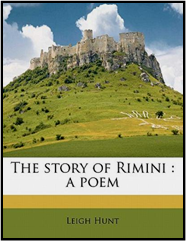 xxxxxTo these early years belong his satirical piece Feast
of the Poets and the narrative poem The
Story of Rimini, published in 1816. The latter, regarded as
his finest poetic work, is based on a tragic event in 13th century
Italy when Francesa da Rimini, daughter of the Lord of Ravenna, was
obliged to marry the none too pleasant Gianciotto Malatesta for
political reasons. He later discovered her in adultery with his
brother Paolo and killed them both. In 1818 he founded The
Indicator, a periodical after the model of Addison’s Spectator, and from it countered attacks upon
his “cockney school of poets” from the Quarterly
Review and Blackwood’s Magazine.
xxxxxTo these early years belong his satirical piece Feast
of the Poets and the narrative poem The
Story of Rimini, published in 1816. The latter, regarded as
his finest poetic work, is based on a tragic event in 13th century
Italy when Francesa da Rimini, daughter of the Lord of Ravenna, was
obliged to marry the none too pleasant Gianciotto Malatesta for
political reasons. He later discovered her in adultery with his
brother Paolo and killed them both. In 1818 he founded The
Indicator, a periodical after the model of Addison’s Spectator, and from it countered attacks upon
his “cockney school of poets” from the Quarterly
Review and Blackwood’s Magazine.
xxxxxIn 1822, at the invitation
of Shelley, he journeyed to Italy to help Shelley and Byron edit a
new radical periodical. Shelley sailed to meet him at Leghorn
(today’s Livorno) and was drowned at sea on his return journey.
Despite this tragedy, Hunt and Byron pressed on with the work, and
together they founded the journal The Liberal,
a magazine which later published a number of Byron’s works. Hunt
stayed on in Italy until 1825, but by then relations between him and
Byron had become strained. On his return he wrote Lord
Byron and Some of His Contemporaries, a book which included
some personal criticism of Byron -
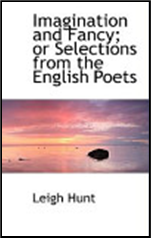
xxxxxOnce settled in England again, he became an established and somewhat respectable critic, writing articles on politics, the fine arts and the theatre for a large number of magazines and newspapers. He became noted for critical but constructive reviews on the work of new poets and writers. In addition he published a play, The Legend of Florence (produced at Covent Garden, London, in 1840), wrote a novel, Sir Ralph Esher, and saw to the publication of works by the English dramatists Wycherley, Farquhar, Congreve and Sheridan. Two collections of his poems were published in 1832 and 1844, and these included The Fish, the Man and the Spirit, Rondeau, and his short narrative poem Abou ben Adhem. His essays covered a wide range of subjects. Some, as in Imagination and Fancy of 1844, wrestled with the relationship between poetry and painting, whilst others discussed mundane matters like the weather, shop windows or walking sticks. And his Autobiography of 1850 throws light not only on the man himself, but also on many of his contemporaries.
xxxxxIt is for his vast array of
essays and critical works rather than for his poetry that Hunt is
remembered today. In fact, however, his major contribution to
English literature was the support he gave to the romantic movement
of his day via articles in his own periodicals -
xxxxxIncidentally, it has been suggested that the character of Harold Skimpole, created by the English writer Charles Dickens in his novel “Bleak House”, published in 1853, was based on Leigh Hunt. If so, it was not a very flattering image of his friend!
xxxxxThe English poet and
essayist Leigh Hunt
(1784-
